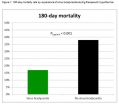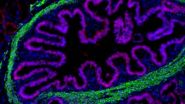(Press-News.org) Geneva, Switzerland – 20 October 2014: Researchers may have developed a way to potentially assist prognostication in the first 24 hours after out-of-hospital cardiac arrest (OHCA) when patients are still in a coma. Their findings are revealed today at Acute Cardiovascular Care 2014 by Dr Jakob Hartvig Thomsen from Copenhagen, Denmark.
Acute Cardiovascular Care is the annual meeting of the Acute Cardiovascular Care Association (ACCA) of the European Society of Cardiology (ESC) and takes place 18-20 October in Geneva, Switzerland.
Dr Thomsen said: "When we talk to relatives and friends immediately after a cardiac arrest we often tell them that we're not able to say much about the prognosis for their Dad, Mom, friend, etc, for the next 3 to 4 days. This is incredibly distressing and loved ones are desperate for more information."
He added: "Therapeutic hypothermia is used in comatose survivors of OHCA to protect them from brain damage. Current recommendations say that prognostication should not be made until 72 hours after hypothermia when patients have returned to normothermia and the sedation has worn off.1 The prognostic tools presently available are not reliable until after this 72 hour period."
Dr Thomsen continued: "During hypothermia some patients lower their heart rate, which is called bradycardia. We hypothesised that this is a normal physiological reaction and that these patients may have less severe brain injury after their arrest and therefore lower mortality."
The study was conducted in the intensive care unit at Copenhagen University Hospital during 2004-2010 and was supported by the EU Interreg IV A programme. It included 234 comatose survivors of OHCA who underwent the hospital's standard 24 hour therapeutic hypothermia protocol. Heart rhythm was measured hourly and sinus bradycardia (defined as less than 50 heart beats per minute) was used to stratify the patients. The primary endpoint was 180 day mortality.
The investigators found that patients who experienced sinus bradycardia during therapeutic hypothermia had a 17% 180 day mortality rate compared to 38% in those with no sinus bradycardia (p END
Heart rate may predict survival and brain function in comatose cardiac arrest survivors
2014-10-20
ELSE PRESS RELEASES FROM THIS DATE:
Study shows medication is frequently, unintentionally given incorrectly to young children
2014-10-20
According to Nationwide Children's Hospital researchers, 63,000 children under the age of six experienced out-of-hospital medication errors annually between 2002 and 2012. One child is affected every eight minutes, usually by a well-meaning parent or caregiver unintentionally committing a medication error.
The most common medication mistakes in children under the age of six occur in the children's home, or another residence and school. The most common medicines involved are painkillers and fever-reducers like ibuprofen and acetaminophen.
"This is more common than people ...
Mummy remains refute antiquity of ankylosing spondylitis
2014-10-20
Ankylosing spondylitis is a systemic disease that causes inflammation in the spinal joints and was thought to have affected members of the ancient Egyptian royal families. Now a new study published in Arthritis & Rheumatology, a journal of the American College of Rheumatology (ACR), refutes that claim, finding instead a degenerative spinal condition called diffuse idiopathic skeletal hyperostosis (DISH) in royal Egyptian mummies from the 18th to early 20th Dynasties.
Ankylosing spondylitis is a member of a group of inflammatory conditions called the spondyloarthropathies ...
Scientists say national Alzheimer's plan milestones must be strengthened to meet goal by 2025
2014-10-20
CHICAGO, OCTOBER 20, 2014 – The U.S. Government has initiated a major effort to prevent and effectively treat Alzheimer's disease by 2025. However, a workgroup of nearly 40 Alzheimer's researchers and scientists says the research milestones in the U.S. Government's National Plan to Address Alzheimer's Disease must be broadened in scope, increased in scale, and adequately funded in order to successfully achieve this goal. A series of proposals by the workgroup to enlarge and strengthen the Plan are published today in Alzheimer's & Dementia: the Journal of the Alzheimer's ...
Head injury causes the immune system to attack the brain
2014-10-20
Scientists have uncovered a surprising way to reduce the brain damage caused by head injuries - stopping the body's immune system from killing brain cells. The study, published in the open access journal Acta Neuropathologica Communications, showed that in experiments on mice, an immune-based treatment reduced the size of brain lesions. The authors suggest that if the findings apply to humans, this could help prevent brain damage from accidents, and protect players of contact sports like American football, rugby and boxing.
To date, there are no effective treatments to ...
Viagra protects the heart beyond the bedroom
2014-10-20
Viagra could be used as a safe treatment for heart disease, finds new research published today in the open access journal BMC Medicine. The study reveals that long-term daily treatment of Viagra can provide protection for the heart at different stages of heart disease, with few side effects.
Phosphodiesterase-5 inhibitor (PDE5i) is the main ingredient in Viagra and other drugs commonly used to treat erectile dysfunction. The inhibitor blocks the enzyme PDE5, which prevents relaxation of smooth muscle tissue. The presence of PDE5 in the heart has led to previous research ...
Group B streptococcus incidence rises significantly among newborns
2014-10-20
The findings suggest that this disturbing trend could be due the emergence of more virulent group B streptococcal strains and call for a renewed evaluation of preventive strategies to reduce neonatal disease.
Passed from mother to child during birth, group B streptococcus is the most common cause of infection in newborns. Guidelines for the prevention of disease have been widely adopted in high-income countries. But despite these efforts, the bacterium remains a leading cause of blood stream infections and meningitis worldwide, typically affecting babies younger than ...
Metabolic genetics research paves way to treating diabetes and obesity
2014-10-19
BETHESDA, MD – Breaking down complex conditions such as Type 2 Diabetes and obesity into the specific metabolic proteins and processes that underlie them offers a new approach to studying the genetics of these diseases and how they are interrelated, according to research presented today at the American Society of Human Genetics (ASHG) 2014 Annual Meeting in San Diego.
By studying specific proteins that contribute to such conditions – and the genes that encode them – scientists can develop new drugs that directly target the metabolic processes that do ...
Improved electricity access has little impact on climate change
2014-10-19
Improving household electricity access in India over the last 30 years contributed only marginally to the nation's total carbon emissions growth during that time, according to a new study published in the journal Nature Climate Change.
"Energy access is fundamental to development: it brings improvements to all aspects of life, including education, communication, and health," says IIASA researcher Shonali Pachauri, who conducted the study.
While increased energy access is widely agreed to be an important goal for development efforts, such as the UN Sustainable Energy ...
Lab-developed intestinal organoids form mature human tissue in mice
2014-10-19
VIDEO:
Michael Helmrath, M.D., M.S., surgical director of the Intestinal Rehabilitation Program at Cincinnati Children's Hospital Medical Center, talks about researchers successfully growing human intestinal tissue in mice. The study describes...
Click here for more information.
CINCINNATI --Researchers have successfully transplanted "organoids" of functioning human intestinal tissue grown from pluripotent stem cells in a lab dish into mice – creating an unprecedented ...
Crystallizing the DNA nanotechnology dream
2014-10-19
DNA has garnered attention for its potential as a programmable material platform that could spawn entire new and revolutionary nanodevices in computer science, microscopy, biology, and more. Researchers have been working to master the ability to coax DNA molecules to self assemble into the precise shapes and sizes needed in order to fully realize these nanotechnology dreams.
For the last 20 years, scientists have tried to design large DNA crystals with precisely prescribed depth and complex features – a design quest just fulfilled by a team at Harvard's Wyss Institute ...



